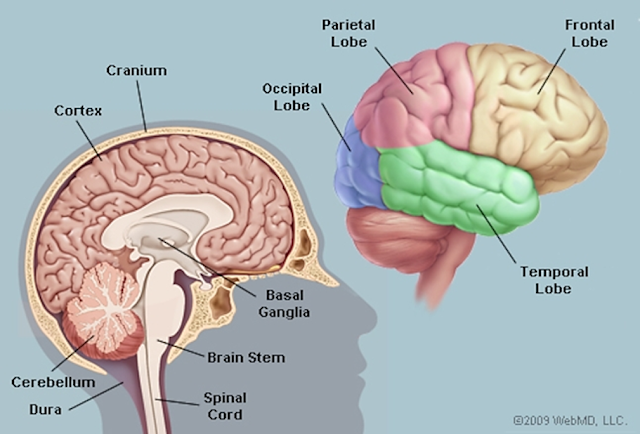The Human brain, a jelly-like substance, is the most important body part and is located inthe head, right under the skull. It is protected by a fluid and the skull (the bone part of the head). The anatomy and the functioning of the brain differ from one animal to another in a lot of different ways. With the help of our brain we can survive (through automatic processes like breathing), think, love, create and remember.
The brain is connected to the entirebodythrough nerves, composing together the nervous system and making other body organs act. For example: when we see an object coming fast towards us, theeyes send the image to the brain. After the information is processed, the brain sends commands through the nerves to our muscles, making our body dodge. More functions of the human brain include muscle control and coordination,sensory receptionand integration, speech production, memory storage, and the elaboration of thought and emotion.
Brain Structure
The brain is one of the largest and most complex organs in the human body. It is made up of more than 100 billion nerves that communicate in trillions of connections calledsynapses. The human brain is made up of many specialised areas that work together:
- The cerebral cortex is the outermost layer of brain cells. Thinking and voluntary movements begin in the cortex.
- The brain stem is between the spinal cord and the rest of the brain. Basic functions like breathing and sleep are controlled here.
- The basal ganglia are a cluster of structures in the centre of the brain. The basal ganglia coordinate messages between multiple other brain areas.
- The cerebellum is at the base and the back of the brain. The cerebellum is responsible for coordination and balance.
The brain is also divided into several lobes:
- The frontal lobesare responsible for problem solving and judgment and motor function.
- The parietal lobesmanage sensation, handwriting, and body position.
- The temporal lobesare involved with memory and hearing.
- The occipital lobescontain the brain’s visual processing system.
The human brain is surrounded by a layer of tissue called the meninges. The skull (cranium) helps protect the brain from injury.
The most common problems in Human Brain
Headache:There are many types of headaches; some can be serious but most are not and are generally treated with analgesics/painkillers.
Stroke (brain infarction):Blood flow and oxygen are suddenly interrupted to an area of brain tissue, which then dies. A blood clot, or bleeding in the brain, are the cause of most strokes.
Intracerebral haemorrhage:Any bleeding inside the brain.
Concussion:A brain injury that causes a temporary disturbance in brain function. Traumatic head injuries cause most concussions.
Cerebral oedema:Swelling of the brain tissue in response to injury or electrolyte imbalances.
Brain tumour:Any abnormal tissue growth inside the brain. Whether malignant (cancer) or benign, brain tumours usually cause problems by the pressure they exert on the normal brain.
Hydrocephalus:An abnormally increased amount of cerebrospinal (brain) fluid inside the skull. Usually this is because the fluid is not circulating properly.
Normal pressure hydrocephalus: A form of hydrocephalus that often causes problems walking, along with dementia and urinary incontinence. Pressures inside the brain remain normal, despite the increased fluid.
Meningitis:Inflammation of the lining around the brain or spinal cord, usually from infection. Stiff neck, neck pain, headache, fever, and sleepiness are common symptoms.
Encephalitis: Inflammation of the brain tissue, usually from infection with a virus. Fever, headache, and confusion are common symptoms.
Traumatic brain injury: Permanent brain damage from a traumatic head injury. Obvious mental impairment, or subtler personality and mood changes can occur.
Parkinson’s disease:Nerves in a central area of the brain degenerate slowly, causing problems with movement and coordination. A tremor of the hands is a common early sign.
Huntington’s disease: An inherited nerve disorder that affects the brain. Dementia and difficulty controlling movements (chorea) are its symptoms.
Epilepsy: The tendency to have seizures. Head injuries and strokes may cause epilepsy, but usually no cause is identified.
Dementia:A decline in cognitive function resulting from death or malfunction of nerve cells in the brain. Conditions in which nerves in the brain degenerate, as well as alcohol abuse and strokes, can cause dementia.
Alzheimer’s disease:For unclear reasons, nerves in certain brain areas degenerate, causing progressive dementia. Alzheimer’s disease is the most common form of dementia.
Больше на Support Centre Center for Elites
Подпишитесь, чтобы получать последние записи по электронной почте.


